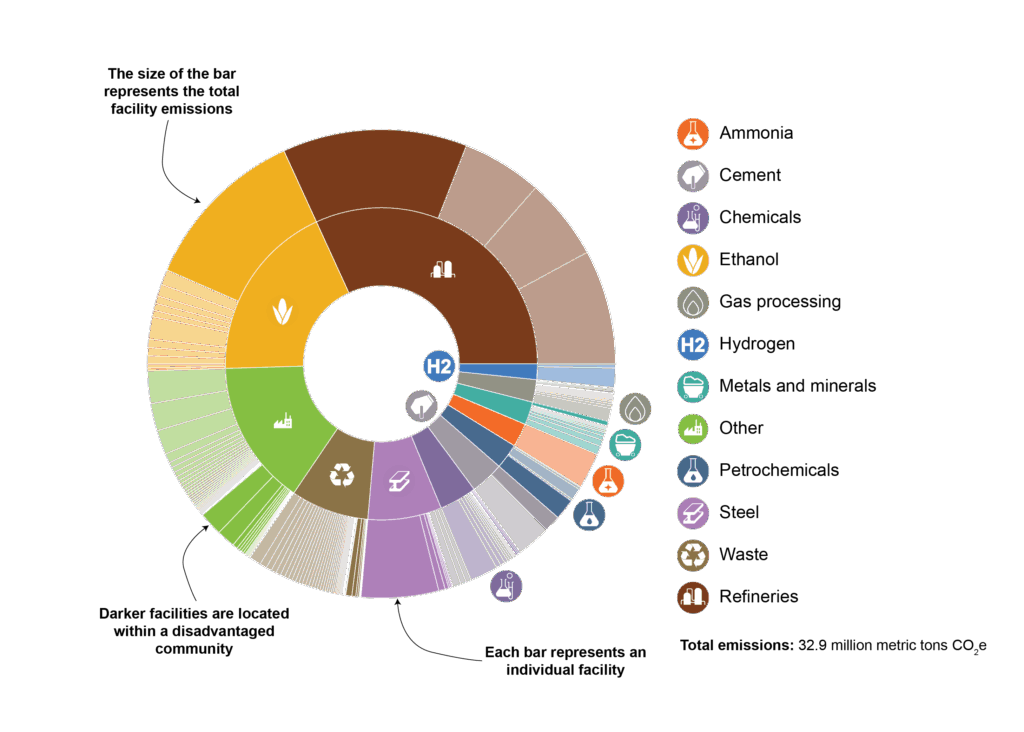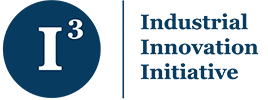Illinois
Illinois ranks among the top ten states in industrial emissions. Its industrial base is exceptionally diverse. Agricultural processing (which the Environmental Protection Agency labels “miscellaneous combustion”) and refineries account for approximately half of industrial emissions. Waste, metals, minerals, and underground coal mines are also significant emitters. Southern Illinois has a long history of coal mining, but industrial production is primarily concentrated in the northern tier of the state. Several large refineries are among the top-emitting industrial facilities in the state.

- This map shows the top 20 emitters, coded by industrial sector. The size of the circles corresponds to emissions: the larger the circle, the higher the emissions.
- Disadvantaged communities (as determined by the federal government) are shaded blue.

- The inner circle provides a visual representation of the share of emissions generated by each industrial sector.
- The outer circle also indicates the share of a sector’s emissions generated in disadvantaged communities.
STATE ENERGY POLICY:
Examining a state’s broader energy policy landscape is helpful when considering policies to support industrial innovation. Illinois has established statutory greenhouse gas emissions targets and a renewable portfolio standard. Illinois does not currently have a Clean Heat Standard, but legislation is being considered in the 2025 session that would direct a 2050 Heat Decarbonization Pathway study. While these formal commitments are not prerequisites for innovative industrial policy, they can provide a supportive framework. In addition, streamlining permitting and establishing an efficient, transparent appeals process that engages local communities early while giving clarity and assurances to project developers are key components of effective state energy policy. Discussions around innovative industrial policy present an opportunity for broader conversations about state energy policy to ensure a mutually reinforcing strategy.
LEGISLATIVE context & opportunity:
Let us know if you are aware of additional legislation advancing industrial innovation in Illinois that should be featured. The context below is not exhaustive and serves as an example of recent policies and programs and where there may be future opportunities:
- Midwest Alliance for Clean Hydrogen (MachH2): Illinois and five other states are part of the Midwest Alliance for Clean Hydrogen. Independent of the outcome of the regional hubs, there is strong interest in building a clean hydrogen economy in the region.
- Several bills are being considered in the 2025 session that would amend the Public Utilities Act to add a 2050 Heat Decarbonization Standard Article and direct a related study to explore pathways for natural gas utilities to achieve the state’s net zero requirements. If enacted or reintroduced, these bills could provide vehicles or direction for innovative industrial policy, including green hydrogen.
- Carbon management technologies are another opportunity to reduce industrial emissions in the state. Learn more about the economically feasible subsectors in Illinois and facilities that qualify for the federal 45Q tax credit.
- A factsheet by the Renewable Thermal Collaborative identifies electrification of Illinois’ s steel, wet corn milling, and ammonia subsectors as opportunities to reduce emissions significantly.
Illinois has enacted and considered a range of legislation that supports industrial modernization, including carbon capture, clean hydrogen, and procurement. Explore recent legislation in Illinois and all 50 states by clicking on a specific year: 2025 legislation, 2024 legislation, 2023 legislation.
